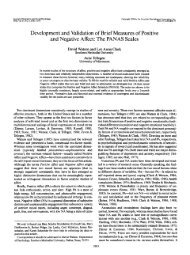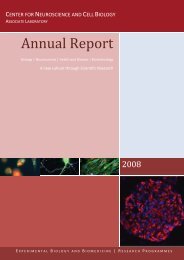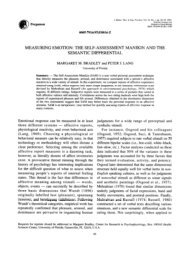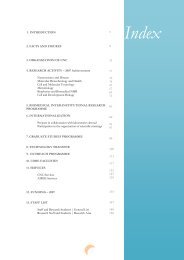Annual Report of Activities CNC 2011 - Center for Neuroscience and ...
Annual Report of Activities CNC 2011 - Center for Neuroscience and ...
Annual Report of Activities CNC 2011 - Center for Neuroscience and ...
You also want an ePaper? Increase the reach of your titles
YUMPU automatically turns print PDFs into web optimized ePapers that Google loves.
42mutations in several protein domains. IV. Ibercivis -‐ A volunteer computing plat<strong>for</strong>m <strong>for</strong> the Iberian Peninsula Throughout <strong>2011</strong> ef<strong>for</strong>ts were made in increasing the general public awareness about the project <strong>and</strong> the integration <strong>of</strong> new Portuguese research teams. Main achievements: The main results achieved by the Structural <strong>and</strong> Computational Biology group are presented below: I. Characterization <strong>of</strong> the molecular mechanisms <strong>of</strong> amyloid <strong>for</strong>mation by the protein transthyretin (TTR) Ia. Refolding kinetics <strong>of</strong> TTR Our results demonstrate that the in vitro refolding mechanisms <strong>of</strong> WT-‐ <strong>and</strong> V30M-‐TTR are similar, involving a dimeric intermediate. However, there are large differences in the refolding rate constants <strong>for</strong> the two variants, specially at nearly native conditions. Interestingly, tetramer <strong>for</strong>mation occurs at a much slower rate in the amyloidogenic variant V30M-‐TTR than in WT-‐TTR, resulting in higher susceptibility <strong>for</strong> aggregation <strong>and</strong> amyloid <strong>for</strong>mation instead <strong>of</strong> spontaneous refolding. Ib. Kinetics <strong>of</strong> the Early Stages <strong>of</strong> TTR Oligomerization The initial steps <strong>of</strong> TTR oligomerization can be described by a three-‐state process. Our results suggest that prior to fibril <strong>for</strong>mation, there is the accumulation <strong>of</strong> an oligomeric intermediate state. After the initial con<strong>for</strong>mational changes, TTR aggregation proceeds via a nucleation-<strong>and</strong>-‐growth mechanism. II. Rational design <strong>of</strong> inhibitors <strong>of</strong> amyloid <strong>for</strong>mation IIa. Characterization <strong>of</strong> Structural <strong>and</strong> Energetic Properties <strong>of</strong> known TTR binders. From ITC experiments it was possible to characterize the binding properties (association constants <strong>and</strong> cooperativity effects) <strong>and</strong> the thermodynamic pr<strong>of</strong>iles <strong>of</strong> the binding between WT-‐TTR <strong>and</strong> four diferent carefully selected lig<strong>and</strong>s. The average total interaction energy computed at structural level follows the same trend <strong>of</strong> the ΔG values determined by ITC. The computational study also suggests that the trend in ΔG values could be primarily determined by shape complementarity (translated into vdW interactions). IIb. Relational Learning Approach to Structure-‐Activity Relationships in Drug Design Toxicity Studies. iLogCHEM, an interactive tool <strong>for</strong> chemo-‐in<strong>for</strong>matics based on ILP, was developed. This system is designed to allow search <strong>and</strong> manipulation <strong>of</strong> drug patterns. The input is given as a st<strong>and</strong>ard <strong>for</strong>matted description <strong>of</strong> the molecules. The output is provided visually, or as text files in st<strong>and</strong>ard chemical file <strong>for</strong>mats. III. Structural modelling <strong>of</strong> viral proteins <strong>and</strong> rational design <strong>of</strong> new anti-‐viral agents IIIa. Modeling <strong>of</strong> the Toll-‐like receptor 3 <strong>and</strong> a putative Toll-‐like receptor 3 antagonist encoded by the African swine fever virus (ASFV). Using homology modeling <strong>and</strong> other structure prediction simulation protocols, we proposed (a) a model <strong>for</strong> the so far experimentally unsolved TLR3-‐TIR structure, assembled within the context <strong>of</strong> the overall TLR3-‐dsRNA recognition complex, <strong>and</strong> (b) a structural model <strong>for</strong> the intracellular extension <strong>of</strong> the pI329L viral protein that rein<strong>for</strong>ces the idea that the viral protein is a TLR3 antagonist. The proposed computational models are consistent with the available experimental data. IIIb. Identification <strong>and</strong> characterization <strong>of</strong> conserved features among different strains/serotypes <strong>of</strong> selected influenza A proteins. ClustalW2 was employed to analyse the sequence alignments <strong>of</strong> sets <strong>of</strong> selected viral proteins. The set <strong>of</strong> clusters obtained identifies conserved sequence regions. These results are currently being interpreted in conjunction with additional relevant epidemiologic in<strong>for</strong>mation on the disease. IV. Ibercivis -‐ A volunteer computing plat<strong>for</strong>m <strong>for</strong> the Iberian Peninsula In July <strong>2011</strong>, a new Portuguese project, named Soluvel, joined Ibercivis <strong>and</strong> started benefiting from the computational power made available by thous<strong>and</strong>s <strong>of</strong> volunteer citizens all over the world.






